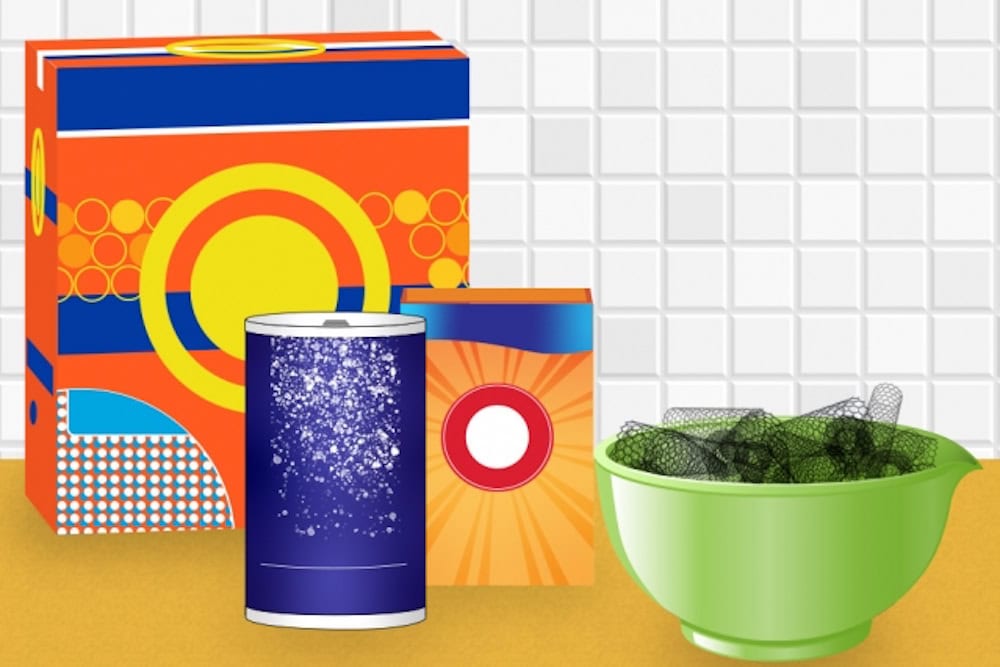
[Image above] Sodium-containing compounds, such as those found in baking soda, table salt, and detergent, are surprisingly effective ingredients for cooking up carbon nanotubes. Credit: Christine Daniloff, MIT
What is made of a single carbon layer and has applications in medicine, water filtration, and electronics?
If you guessed graphene, you would be close. But there is another material that fits the description—carbon nanotubes (CNTs).
CNTs are essentially a rolled sheet of graphene and can be either multiwalled (multiple sheets) or single walled (one sheet). The tube shape provides CNTs with properties not seen in 2D graphene. For example, while graphene is a semimetal, CNTs can be either metallic or semiconducting depending upon the tube’s diameter and the “rolling” angle between the graphene lattice and axis.
However, despite providing a useful visualization, CNTs are not actually created by rolling a sheet of graphene, as this fabrication method comes with multiple difficulties. Instead, it is much easier for scientists to grow CNTs vertically on a substrate in their tube form with the desired lattice orientation.
Of the three main CNT synthesis methods—arc discharge, laser ablation, and chemical vapor deposition (CVD)—CVD appears the most promising method for achieving mass CNT production because it can accurately control physical characteristics such as nanotube length, diameter, and lattice orientation.
In CVD processing, gaseous carbon-containing molecules, such as hydrocarbons and carbon dioxide, are flowed over a substrate containing catalytic particles. The catalysts decompose the carbon-containing gas, freeing carbon atoms to build up in vertical tubes.
Although CVD occurs at relatively low temperatures compared to arc discharge and laser ablation, CVD still typically takes place at temperatures over 700°C (1,292°F). These temperatures are required because the most common catalyst materials are nickel, cobalt, and iron.
These metals have large work functions, or the minimum quantity of energy required to remove an electron from the metal’s surface. Therefore, high temperatures are needed to provide enough energy to free electrons to react with and decompose the carbon-containing gas.
The high temperatures required to activate these common metallic catalysts limit the materials from which the substrate can be made, which can be problematic, particularly in aerospace applications.
“In aerospace composites, there are a lot of polymers that hold carbon fibers together,” Richard Li, a graduate student in the Massachusetts Institute of Technology’s Department of Aeronautics and Astronautics, says in an MIT press release.
However, because polymers melt at much lower temperatures than the temperatures required for CNT synthesis, it is not possible to directly grow CNTs on the polymers. If CNTs could be grown directly, though, it would “make stronger, tougher, stiffer composites,” Li adds.
But do all metallic catalysts confine us to these higher temperatures? Li and his colleagues have one response: Na.
In a recent study published in the journal Angewandte Chemie, Li and colleagues from MIT, Harvard University, and National Institute of Standards and Technology explain how it is possible to grow CNTs at lower temperatures using the alkali metal sodium (Na) as a catalyst, a discovery they made by chance.
The researchers were experimenting with ways to grow CNTs using different iron-containing compounds when they noticed the resulting CNTs looked a bit unusual.
“The tubes looked a little funny,” MIT professor of aeronautics and astronautics Brian Wardle says in the press release. So, “Rich and the team carefully peeled the onion back … and it turns out a small quantity of sodium, which we suspected was inactive, was actually causing all the growth.”
To verify their initial observation was not just a fluke, the team went to the campus convenience store and bought several common household items that contain various sodium compounds, including baking soda (NaHCO3), table salt (NaCl), and detergents (washing soda, Na2Co3; lye, NaOH). They initially experimented with these commercial-grade sources of sodium before upgrading to purified versions of the compounds.
In contrast to iron catalysts, which synthesized CNTs around 800°C, sodium catalysts synthesized short, dense CNTs around 480°C—a temperature that high-temperature structural polymers can handle!
In addition to lowering synthesis temperature so that polymers could be used as substrates, the researchers found another advantage to sodium catalysts—they leave no residue behind in the CNTs.
“A large part of CNT research is not on growing them, but on cleaning them—getting the different metals used to grow them out of the product,” Wardle says in the press release. “The neat thing with sodium is, we can just heat it and get rid of it, and get pure CNT as product, which you can’t do with traditional catalysts.”
There are still a few drawbacks to the sodium process that the researchers hope to address in future work. Specifically, CNTs grown using sodium catalysts have walls that are not perfectly aligned in hexagonal patterns, the configuration that gives CNTs their characteristic strength. Li plans to investigate the timing, temperature, and environmental conditions of the CVD process to improve the quality of sodium-grown CNTs.
I guess we can add a few more items to the list of common household ingredients that can help develop advanced materials!
The paper, published in Angewandte Chemie, is “Low-temperature growth of carbon nanotubes catalyzed by sodium-based ingredients” (DOI: 10.1002/anie.201902516).
Author
Lisa McDonald
CTT Categories
- Nanomaterials



